

Stempel AG’s DIN Neuzeit, created by Wilhelm Pischner between 19. Stempel AG and the Linotype Design Studio in 1966. For more information about these parameters, see Font Substitution options.The Neuzeit Office family is designed after the model of the original sans serif family Neuzeit S™, which was produced by D. Note: You can control font substitution by adding parameters to the HTML file that loads the viewer. If neither arial unicode is found, the viewer uses a default font. For example, if the preceding list is used and a document contains arial unicode font, the viewer attempts to substitute the arial unicode ms font.

If neither the font nor its substitute is found, the viewer generates a default font. If a font is not found, the viewer uses the substitute font. For example, this file might list the following fonts: In this file, list alternative names for fonts and any equivalent fonts to substitute for fonts that are not available. Optionally, create a file called officefontaliases.txt in the same folder.In the v1 folder, create a file called officeadditionalfonts.txt and list the fonts that you want to support.Add the following parameters to the HTML file that loads the viewer:.You can prevent the loading of OpenType fonts by adding the following parameter to the HTML file that loads the viewer: Therefore, you cannot use OpenType fonts for IBM Daeja ViewONE Virtual or the ViewONE Permanent Redaction Server Module.įor IBM Daeja ViewONE Professional, OpenType fonts are enabled on the client by default. As a result, OpenType fonts are disabled on the server.

Beginning in V4.1.2, the IBM Daeja ViewONE Office Module supports all TrueType and OpenType fonts that are in the following folders:īecause of a bug in IBM JRE, loading certain OpenType fonts causes the JRE to crash.


 0 kommentar(er)
0 kommentar(er)
